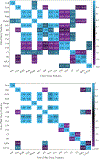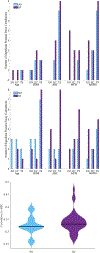Chest-Based Wearables and Individualized Distributions for Assessing Postural Sway in Persons With Multiple Sclerosis
- PMID: 37067975
- PMCID: PMC10408383
- DOI: 10.1109/TNSRE.2023.3267807
Chest-Based Wearables and Individualized Distributions for Assessing Postural Sway in Persons With Multiple Sclerosis
Abstract
Typical assessments of balance impairment are subjective or require data from cumbersome and expensive force platforms. Researchers have utilized lower back (sacrum) accelerometers to enable more accessible, objective measurement of postural sway for use in balance assessment. However, new sensor patches are broadly being deployed on the chest for cardiac monitoring, opening a need to determine if measurements from these devices can similarly inform balance assessment. Our aim in this work is to validate postural sway measurements from a chest accelerometer. To establish concurrent validity, we considered data from 16 persons with multiple sclerosis (PwMS) asked to stand on a force platform while also wearing sensor patches on the sacrum and chest. We found five of 15 postural sway features derived from the chest and sacrum were significantly correlated with force platform-derived features, which is in line with prior sacrum-derived findings. Clinical significance was established using a sample of 39 PwMS who performed eyes-open, eyes-closed, and tandem standing tasks. This cohort was stratified by fall status and completed several patient-reported measures (PRM) of balance and mobility impairment. We also compared sway features derived from a single 30-second period to those derived from a one-minute period with a sliding window to create individualized distributions of each postural sway feature (ID method). We find traditional computation of sway features from the chest is sensitive to changes in PRMs and task differences. Distribution characteristics from the ID method establish additional relationships with PRMs, detect differences in more tasks, and distinguish between fall status groups. Overall, the chest was found to be a valid location to monitor postural sway and we recommend utilizing the ID method over single-observation analyses.
Figures





Similar articles
-
Assessing Free-Living Postural Sway in Persons With Multiple Sclerosis.IEEE Trans Neural Syst Rehabil Eng. 2024;32:967-973. doi: 10.1109/TNSRE.2024.3366903. Epub 2024 Feb 28. IEEE Trans Neural Syst Rehabil Eng. 2024. PMID: 38373134 Free PMC article.
-
Coherence analysis of trunk and leg acceleration reveals altered postural sway strategy during standing in persons with multiple sclerosis.Hum Mov Sci. 2018 Apr;58:330-336. doi: 10.1016/j.humov.2017.12.009. Epub 2017 Dec 23. Hum Mov Sci. 2018. PMID: 29277247 Free PMC article.
-
Kinematic Validation of Postural Sway Measured by Biodex Biosway (Force Plate) and SWAY Balance (Accelerometer) Technology.Biomed Res Int. 2019 Dec 21;2019:8185710. doi: 10.1155/2019/8185710. eCollection 2019. Biomed Res Int. 2019. PMID: 31930140 Free PMC article.
-
Metrics extracted from a single wearable sensor during sit-stand transitions relate to mobility impairment and fall risk in people with multiple sclerosis.Gait Posture. 2020 Jul;80:361-366. doi: 10.1016/j.gaitpost.2020.06.014. Epub 2020 Jun 20. Gait Posture. 2020. PMID: 32615409 Free PMC article.
-
Pierre-Marie Gagey and the Evolution of Posturology: Unraveling the Complexity of the Fine Postural Control System.Cureus. 2024 Sep 10;16(9):e69052. doi: 10.7759/cureus.69052. eCollection 2024 Sep. Cureus. 2024. PMID: 39391446 Free PMC article. Review.
Cited by
-
Measuring gait parameters from a single chest-worn accelerometer in healthy individuals: a validation study.Sci Rep. 2024 Jun 17;14(1):13897. doi: 10.1038/s41598-024-62330-6. Sci Rep. 2024. PMID: 38886358 Free PMC article.
-
Smartphone postural sway and pronator drift tests as measures of neurological disability.BMC Neurol. 2025 Feb 5;25(1):50. doi: 10.1186/s12883-025-04038-2. BMC Neurol. 2025. PMID: 39910508 Free PMC article.
-
Real-World Postural Transitions as Biomarkers of Functional Impairment in Duchenne Muscular Dystrophy.Digit Biomark. 2025 Mar 29;9(1):75-87. doi: 10.1159/000545617. eCollection 2025 Jan-Dec. Digit Biomark. 2025. PMID: 40416999 Free PMC article.
-
Assessing Free-Living Postural Sway in Persons With Multiple Sclerosis.IEEE Trans Neural Syst Rehabil Eng. 2024;32:967-973. doi: 10.1109/TNSRE.2024.3366903. Epub 2024 Feb 28. IEEE Trans Neural Syst Rehabil Eng. 2024. PMID: 38373134 Free PMC article.
-
Smartphone Postural Sway and Pronator Drift tests as Measures of Neurological Disability.medRxiv [Preprint]. 2024 Nov 21:2024.11.20.24317196. doi: 10.1101/2024.11.20.24317196. medRxiv. 2024. Update in: BMC Neurol. 2025 Feb 05;25(1):50. doi: 10.1186/s12883-025-04038-2. PMID: 39802775 Free PMC article. Updated. Preprint.
References
-
- Muir SW, Berg K, Chesworth B, Klar N, and Speechley M, “Quantifying the magnitude of risk for balance impairment on falls in community-dwelling older adults: A systematic review and meta-analysis,” J. Clin. Epidemiol, vol. 63, no. 4, pp. 389–406, Apr. 2010, doi: 10.1016/j.jclinepi.2009.06.010. - DOI - PubMed
-
- Schwartz I, Kandel L, Sajina A, Litinezki D, Herman A, and Mattan Y, “Balance is an important predictive factor for quality of life and function after primary total knee replacement,” J. Bone Joint Surg. Brit. Volume, vol. 94-B, no. 6, pp. 782–786, Jun. 2012, doi: 10.1302/0301-620X.94B6.27874. - DOI - PubMed
Publication types
MeSH terms
Grants and funding
LinkOut - more resources
Full Text Sources
Medical

